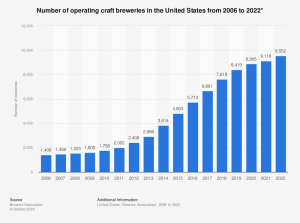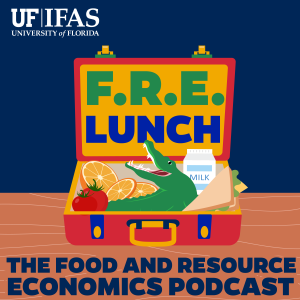While working for a local craft brewery in college, FRE assistant professor Nathan Palardy never sold a single beer. However, the brewery sold plenty of tours.
“At the time, Georgia had regulations that said you couldn’t sell beer directly to consumers if you were a brewery,” Palardy explains. “If you were a brewery, you could sell a tour to people, but at that tour, you were allowed to give a limited number of ‘free samples.’”
His time at Terrapin Beer Co. awakened a passion for the industry and a curiosity about its regulations, which has been a focal point for his research program ever since.
“I thought this was strange, so I looked into it and figured out that this was one of many strange laws regulating alcohol distribution and sales,” Palardy explained. “Later on, I decided to make the impact of these policies the subject of my Ph.D. research.”
And so, as Oktoberfest celebrations began in full swing, Palardy joined us for the latest episode of F.R.E. Lunch: The Food and Resource Economics Podcast to explore the craft beer industry in America. In this episode, he discusses his research on how policy changes impact the brewing industry, the overall trends that impact these businesses, and their ability to succeed in different regions.
The Craft Brewing Industry in America
So, what exactly is a craft beer? And how popular are they?
According to the Brewer’s Association, an American brewery must be small (producing 6 million barrels of beer or less annually) and independent (less than 25% owned by a beverage alcohol industry member who is not a craft brewer).
With over 9,500 craft breweries operating across the United States, the Craft Beer Industry has grown steadily over the past two decades.

Economic Impacts of Craft Breweries
As the industry continues to grow, so has its economic impact. The industry is estimated to contribute about $72 billion to the U.S. economy per year, and its impact goes way beyond just the number of cans sold.
Breweries provide jobs in brewing, customer service, and marketing and work with other local businesses to extend their impact even further. According to the Brewer’s Association, the industry provides over 460,000 jobs annually.
Other research studies have also shown that by drawing business into an area, they can also increase commercial property values and contribute to the revitalization of urban spaces.
“Breweries are being more and more recognized for the role they play as community gathering places,” Palardy said.
How Policy Changes Can Impact the Business of Breweries
When it comes to his own research, Palardy focuses in on how things like legislation changes can impact a brewery’s success in an area.
His recently published research into how changes to laws allowing for the sale of beer in Colorado grocery stores impacted the state’s regional craft breweries uses things like foot traffic data to see how consumer shopping shifted over this time and examines some of the barriers to entry that would make it harder for small breweries to get shelf space in grocery stores and compete with larger brands and distributors.
Want to Learn More?

To learn more about Dr. Palardy’s research, the economic impact of craft breweries on local communities, and how different policies impact the viability of craft breweries, listen to the latest episode of F.R.E. Lunch.
Tune in here: https://fred.ifas.ufl.edu/fre-lunch-podcast
F.R.E. Lunch is the official podcast of the UF/IFAS Food and Resource Economics Department, showcasing how economics can help us understand and address the complex issues facing agricultural and natural resource industries. Each month, a short 15—to 20-minute episode features FRE faculty and student research presented in a bite-sized, easily digestible format that will surely bring you back for seconds.
 2
2
